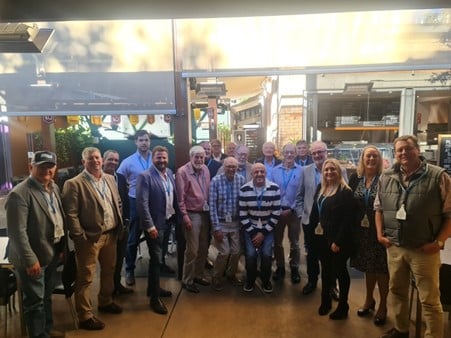July CEO Message
27 July 2025 | 7-Min Read
To begin, I wanted to note the Australian Government’s recent decision to permit beef imports from the United States and Canada. This change follows the completion of an extensive review and comprehensive risk assessment by the Department of Agriculture, Fisheries and Forestry (DAFF).
DAFF and the competent authorities in both countries have now finalised health certifications and import permit conditions for both Canada and the United States. These reflect the stringent safeguards required to prevent the introduction of exotic diseases and ensure Australia remains one of the strictest biosecurity regimes in the world.
It’s also important to note that these changes are unlikely to have an adverse impact on the competitiveness of Australian cattle producers. With America’s herd numbers now at their lowest point since 1951, US demand for Australian beef only continues to grow. This fact – coupled with the strong Australian dollar and our competitive domestic supply – make it unlikely that large volumes of US beef will enter the Australian market as a result of the Australian Government’s recent decision.
If you would like more information, this recent statement from Meat and Livestock Australia explains these changes in more detail.
NVD Review survey
Thank you to everyone who has already completed the NVD Review survey I shared earlier this month. So far, we’ve had more than 2,000 responses and the survey remains open until midnight on Thursday 31 July, so there’s still time to share your views on the NVD.
Streamlining livestock transfers
New functionality is now available in the eNVD web system, providing livestock receivers with the option to update the NLIS database directly from the eNVD. If you are keen to try this new function, July’s eNVD Featured Function includes a comprehensive user guide for both senders and receivers. Alternatively, you can watch the following video for more information on using this feature.
I also wanted to quickly thank those of you who tested and provided feedback on this new functionality – user feedback is critical to improving the eNVD and our development team was very grateful for your insights.
ISC Roadshow
Our teams continue to be out on the road meeting producers.
Over the past month we’ve attended the Australian Saleyards Conference in Wagga Wagga, the RMA Conference in Adelaide, the NSW Farmers Conference in Sydney, and the Victorian Farmers’ Federation Conference and Australian Sheep and Wool Show (both of which were held in Bendigo).
We were also at MLA’s MeatUp and BeefUp forums in Wagga Wagga and Alice Springs, so it’s been a busy month.
Please check our events page to see what other events we’ll be attending over the next month.
Ekka 2025
ISC will also be at Brisbane’s Ekka during this year’s Beef Week – ready to meet producers and answer questions about the eNVD, LPA and NLIS. If you’re onsite during Beef Week, I hope you’ll stop by our table in the Live Animal Pavillion on 5 or 6 August and say hello to the team.
LPA success over the past year
The new LPA requirement regarding Animal Welfare Management Plans (AWMP) has been well received by producers, with more than 4,000 having completed a plan since it was launched in June. Completing an AWMP is a great opportunity for producers to become more familiar with the Australian Animal Welfare Standards and Guidelines.
Despite overwhelmingly positive coverage, some misleading media statements created confusion for producers around the use of working dogs and how this is captured in the AWMP.
I wanted to take this opportunity to note that LPA does not restrict the use of working dogs. All that has changed is there is now a requirement to complete an AWMP as part of your LPA accreditation, and there is a new tool in LPA to help you do this. The questions you are asked when completing the plan are aligned to the information contained in the Australian Animal Welfare Standards and Guidelines which were endorsed in January 2016 and have not changed since then.
In relation to working dog use, the guidelines for sheep state: The use of dogs and handling aids should be limited to the minimum needed to complete the task – a requirement that many producers already meet. If you would like more information, you can refer to Working dogs on Australian sheep farms and the LPA.
Of course, we all know the value of a good working dog on-farm cannot be underestimated!
NLIS milestones
While we continue to forge ahead to uplift the NLIS Database, it’s worth remembering that the existing National Livestock Identification System has been in operation since 1999 – when it was first introduced as part of the European Union Cattle Accreditation Scheme (EUCAS). It was then mandated for use in Victorian cattle from 2002, with other states progressively adopting it after that.
In 2005, it became a mandatory requirement for Queensland cattle and some of NLIS’s key players gathered in Brisbane recently to celebrate this significant 20 year milestone.
Those attending included Bomber Lancaster (ALFA), Paul Gibson (ACC) and Geoff Teys, as well as ISC’s George Basha and Elizabeth Bradley. MLA/ISC alumni including Rick Beasley, Kevin Markey and Mick Prendergast were also there, as well as representatives from Allflex and Cattle Australia.

It’s great to see the team coming together to celebrate the history of something that has played such a transformative role in the success of Australia’s red meat industry, both here and abroad.
As we prepare for an uplifted NLIS Database in 2026, I look forward to sharing more news of our progress through stages 4 and 5 over the coming months.
In the meantime, I hope you enjoy this month’s edition of Integrity Matters.
Kind regards,
Jo Quigley
ISC CEO